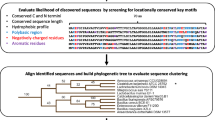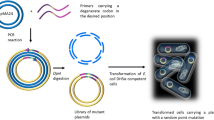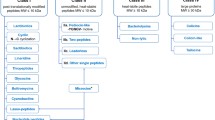Abstract
Bacteriocin AS-48 is an intriguing molecule because of its unique structural characteristics, genetic regulation, broad activity spectrum, and potential biotechnological applications. It was the first reported circular bacteriocin and has been undoubtedly the best characterized for the last 25 years. Thus, AS-48 is the prototype of circular bacteriocins (class IV), for which the structure and genetic regulation have been elucidated. This review discusses the state-of-the-art in genetic engineering with regard to this circular protein, with the use of site-directed mutagenesis and circular permutation. Mutagenesis studies have been used to unravel the role of (a) different residues in the biological activity, underlining the relevance of several residues involved in membrane interaction and the low correlation between stability and activity and (b) three amino acids involved in maturation, providing information on the specificity of the leader peptidase and the circularization process itself. To investigate the role of circularity in the stability and biological properties of the enterocin AS-48, two different ways of linearization have been attempted: in vitro by limited proteolysis experiments and in vivo by circular permutation in the structural gene as-48A. The results summarized here show the significance of circularization on the secondary structure, potency and, especially, the stability of AS-48 and point as well to a putative role of the leader peptide as a protecting moiety in the pre-proprotein. Taken all together, the data available on circular bacteriocins support the idea that AS-48 has been engineered by nature to make a remarkably active and stable protein with a broad spectrum of activity.





Similar content being viewed by others
References
Scott CP, Abel-Santos E, Wall M, Wahnon DC, Benkovic SJ (1999) Production of cyclic peptides and proteins in vivo. Proc Natl Acad Sci USA 96:13638–13643
Iwai H, Lingel A, Pluckthun A (2001) Cyclic green fluorescent protein produced in vivo using an artificially split PI-PfuI intein from Pyrococcus furiosus. J Biol Chem 276:16548–16554
Mulvenna JP, Wang C, Craik DJ (2006) CyBase, a database of cyclic protein sequence structure. Nucleic Acid Res 34:D192–D194
Conlan BF, Gillon AD, Craik DJ, Anderson MA (2010) Circular proteins and mechanisms of cyclization. Biopolymers 94:573–583
Cascales L, Craik DJ (2010) Naturally occurring circular proteins: distribution, biosynthesis and evolution. Org Biomol Chem 8:5035–5047
Garcia AE, Camarero JA (2010) Biological activities of natural and engineered cyclotides, a novel molecular scaffold for peptide-based therapeutics. Curr Mol Pharmacol 3:153–163
Riley MA, Wertz JE (2002) Bacteriocins: evolution, ecology, and application. Ann Rev Microbiol 56:117–137
Willey JM, van der Donk WA (2007) Lantibiotics: peptides of diverse structure and function. Annu Rev Microbiol 61:477–501
Heng NCK, Wescombe PA, Burton JP, Jack RW, Tagg JR (2007) The diversity of bacteriocins produced by Gram-positive bacteria. In: Riley MA, Chavan MA (eds) Bacteriocins. Ecology and evolution. Springer, Berlin Heidelberg New York, pp 45–92
Maqueda M, Sánchez-Hidalgo M, Fernández M, Montalbán-López M, Valdivia E, Martínez-Bueno M (2008) Genetic features of circular bacteriocins produced by Gram-positive bacteria. FEMS Microbiol Rev 32:2–22
Martin-Visscher LA, Gong X, Duszyk M, Vederas JC (2009) The three-dimensional structure of carnocyclin A reveals that many circular bacteriocins share a common structural motif. J Biol Chem 284:28674–28681
Martin-Visscher LA, van Belkum MJ, Garneau-Tsodikova S, Whittal RM, Zheng J, McMullen LM, Vederas JC (2008) Isolation and characterization of carnocyclin A, a novel circular bacteriocin, produced by Carnobacterium maltaromaticum UAL307. Appl Environ Microbiol 74:4756–4763
Sawa N, Zendo T, Kiyofuji J, Fujita K, Himeno K, Nakayama J, Sonomoto K (2009) Identification and characterization of lactocyclicin Q, a novel cyclic bacteriocin produced by Lactococcus sp strain QU 12. Appl Environ Microbiol 75:1552–1558
Kemperman R, Jonker M, Nauta A, Kuipers OP, Kok J (2003) Functional analysis of the gene cluster involved in production of the bacteriocin circularin A by Clostridium beijerinckii ATCC 25752. Appl Environ Microbiol 69:5839–5848
Maqueda M, Gálvez A, Martínez-Bueno M, Sánchez-Barrena MJ, González C, Albert A, Rico M, Valdivia E (2004) Peptide AS-48, prototype of a new class of cyclic bacteriocins. Curr Prot Pept Sci 5:399–416
Wirawan RE, Swanson KM, Kleffmann T, Jack RW, Tagg JR (2007) Uberolysin, a novel cyclic bacteriocin produced by Streptococcus uberis. Microbiology 153:1619–1630
Borrero J, Brede DA, Skaugen M, Diep DB, Herranz C, Nes IF, Cintas LM, Hernández P (2011) Characterization of garvicin ML, a novel circular bacteriocin produced by Lactococcus garvieae DCC43, isolated from mallard ducks (Anas platyrhynchos). Appl Environ Microbiol 77:369–373
Arakawa K, Kawai Y, Ito Y, Nakamura K, Chujo T, Nishimura J, Kitazawa H, Saito T (2010) HPLC purification and re-evaluation of chemical identity of two circular bacteriocins, gassericin A and reutericin 6. Lett Appl Microbiol 50:406–411
Kawai Y, Kemperman R, Kok J, Saito T (2004) The circular bacteriocins gassericin A and circularin A. Curr Prot Pept Sci 5:393–398
Kalmokoff ML, Teather RM (1997) Isolation and characterization of a bacteriocin (butyrivibriocin AR10) from the ruminal anaerobe Butyrivibrio fibrisolvens AR10: evidence in support of the widespread occurrence of bacteriocin-like activity among ruminal isolates of B. fibrisolvens. Appl Environ Microbiol 63:394–402
Kawulka K, Sprules T, McKay RT, Mercier P, Diaper CM, Zuber P, Vederas JC (2003) Structure of subtilosin A, an antimicrobial peptide from Bacillus subtilis with unusual post-translational modifications linking cysteine sulfurs to alpha-carbons of phenylalanine and threonine. J Am Chem Soc 125:4726–4727
Kawulka KE, Sprules T, Diaper CM, Whittal RM, McKay RT, Mercier P, Zuber P, Vederas JC (2004) Structure of subtilosin A, a cyclic antimicrobial peptide from Bacillus subtilis with unusual sulfur to alpha-carbon cross-links: formation and reduction of alpha-thio-alpha-amino acid derivatives. Biochemistry 43:3385–3395
Abriouel H, Lucas R, Ben Omar N, Valdivia E, Gálvez A (2010) Potential applications of the cyclic peptide enterocin AS-48 in the preservation of vegetable foods beverages. Probiotics Antimicrob Prot 2:77–89
Khan H, Flint S, Pak-Lam Yu (2010) Enterocins in food preservation. Intern J Food Microbiol 141:1–10
Davidse EK, Balla E, Holzapfel WH, Muller CJC, Cloete SWP, Dicks LMT (2004) Peptide AS-48 from Enterococcus faecalis for prevention and treatment of mastitis in dairy cows. Online J Veter Res 8:22–32
Fernández M, Sánchez-Hidalgo M, García-Quintáns N, Martínez-Bueno M, Valdivia E, López P, Maqueda M (2008) Processing of as-48ABC RNA in AS-48 enterocin production by Enterococcus faecalis. J Bacteriol 190:240–250
Martínez-Bueno M, Valdivia E, Gálvez A, Coyette J, Maqueda M (1998) Analysis of the gene cluster involved in production and immunity of the peptide antibiotic AS-48 in Enterococcus faecalis. Mol Microbiol 27:347–358
Sánchez-Hidalgo M, Martínez-Bueno M, Fernández-Escamilla AM, Valdivia E, Serrano L, Maqueda M (2008) Effect of replacing glutamic residues upon the biological activity and stability of the circular enterocin AS-48. J Antimicrob Chemother 61:1256–1265
Sánchez-Hidalgo M, Fernández-Escamilla AM, Martínez-Bueno M, Valdivia E, Serrano L, Maqueda M (2010) Conformational stability and activity of circular Enterocin AS-48 derivatives. Prot Pept Let 17:708–714
Cebrián R, Maqueda M, Neyra JL, Valdivia E, Martinez-Bueno M, Montalbán-López M (2010) Insights into the functionality of the putative residues involved in AS-48-maturation. Appl Environ Microbiol 76:7268–7276
Plat A, Kluskens LD, Kuipers A, Rink R, Moll GN (2011) Requirements of the engineered leader peptide of nisin for inducing modification, export, and cleavage. Appl Environ Microbiol 77:604–611
Szekat C, Jack RW, Skutlarek D, Farber H, Birbaum G (2003) Construction of an expression system for site-directed mutagenesis of the lantibiotic mersacidin. Appl Environ Microbiol 69:378–3777
Tyndall JDA, Nall T, Fairlie DP (2005) Proteases universally recognize beta strands in their active sites. Chem Rev 105:973–999
Phan UT, Lackman RL, Cresswell P (2002) Role of the C-terminal propeptide in the activity and maturation of gamma -interferon-inducible lysosomal thiol reductase (GILT). Proc Natl Acad Sci USA 99:12298–12303
Abriouel H, Lucas R, Ben Omar N, Martínez-Bueno M, Valdivia E, Maqueda M, Martínez-Cañamero M, Gálvez A (2005) Enterocin AS-48RJ, a variant of enterocin AS-48 chromosomally encoded by the food isolate Enterococcus faecium RJ16. Syst Appl Microbiol 28:383–397
Fimland G, Eijsink VGH, Nissen-Meyer J (2002) Mutational analysis of the role of tryptophan residues in an antimicrobial peptide. Biochemistry 41:9508–9515
Killian JA, von Heijne G (2000) How proteins adapt to a membrane-water interface. Trends Biochem Sci 25:429–434
Ridder ANJA, Morein S, Stam JG, Kuhn A, de Kruijff B, Killian JA (2000) Analysis of the role of interfacial tryptophan residues in controlling the topology of membrane proteins. Biochemistry 39:6521–6528
Knappe TA, Linne U, Robbel L, Marahiel MA (2009) Insights into the biosynthesis and stability of the lasso peptide capistruin. Chem Biol 16:1290–1298
Morisset D, Berjeaud JM, Marion D, Lacombe C, Frère J (2004) Mutational analysis of mesentericin Y105, an anti-Listeria bacteriocin, for determination of impact on bactericidal activity, in vitro secondary structure, and membrane interaction. Appl Environ Microbiol 70:4672–4680
Yuan J, Zhang ZZ, Chen XZ, Yang W, Huan ZLD (2004) Site-directed mutagenesis of the hinge region of nisin Z and properties of nisin Z mutants. Appl Microbiol Biotechnol 64:806–815
Hasper HE, Kramer NE, Smith JL, Hillman JD, Zachariah C, Kuipers OP, de Kruijff B, Breukink E (2006) An alternative bactericidal mechanism of action for lantibiotic peptides that target lipid II. Science 313:1636–1637
Montalbán-López M, Spolaore B, Pinato O, Martínez-Bueno M, Valdivia E, Maqueda M, Fontana A (2008) Characterization of linear forms of the circular enterocin AS-48 obtained by limited proteolysis. FEBS Lett 582:3237–3242
Schymkowitz J, Borg J, Stricher F, Nys R, Rousseau F, Serrano L (2005) The FoldX web server, an online force field. Nucleic Acids Res 33:W382–W388
Shental-Bechor D, Haliloglu T, Ben-Tal N (2007) Interactions of cationic-hydrophobic peptides with lipid bilayers, a Monte Carlo simulation method. Biophys J 93:1858–1871
Simonsen SM, Daly NL, Craik DJ (2004) Capped acyclic permutants of the circular protein kalata B1. FEBS Lett 577:399–402
Ireland DC, Colgrave ML, Nguyencong P, Daly NL, Craik DJ (2006) Discovery and characterization of a linear cyclotide from Viola odorata, implications for the processing of circular proteins. J Mol Biol 357:1522–1535
Hawai Y, Arakawa K, Itoh A, Saitoh B, Ishii Y, Nishimura J, Kitazawa H, Itoh T, Saito T (2003) Heterologous expression of gassericin A, a bacteriocins produced by Lactobacillus gasseri LA39. Anim Sci J 74:45–51
Cobos ES, Filimonov VV, Gálvez A, Valdivia E, Maqueda M, Martínez JC, Mateo PL (2002) The denaturation of circular enterocin AS-48 by urea and guanidinium hydrochloride. Biochim Biophys Acta 1598:98–107
Montalbán-López M, Martínez-Bueno M, Valdivia E, Maqueda M (2011) Expression of linear permutated variants from circular enterocin AS-48. Biochimie 93:549–555
Oman TJ, van der Donk WA (2010) Follow the leader: the use of leader peptides to guide natural product biosynthesis. Nat Chem Biol 6:9–18
Tsai CJ, Ma B, Nussinov R (2009) Intra-molecular chaperone: the role of the N-terminal in conformational selection and kinetic control. Phys Biol 6:013001–013009
Li L, Shakhnovich EI (2001) Different circular permutations produced different folding nuclei in proteins: a computational study. J Mol Biol 306:121–132
Terpe K (2003) Overview of tag protein fusions: from molecular and biochemical fundamentals to commercial systems. Appl Microbiol Biotechnol 60:523–533
Jiménez MA, Barrachi-Saccilotto AC, Valdivia E, Maqueda M, Rico M (2005) Design, NMR characterization and activity of a 21-residue peptide fragment of bacteriocin AS-48 containing its putative membrane interacting region. J Pept Sci 11:29–36
Acknowledgments
Work in our laboratory was supported by grants BIO2005-01544 and BIO2008-01708 (Ministerio de Ciencia e Innovación, Spain) and PAI CVI 160 (Junta de Andalucía).
Author information
Authors and Affiliations
Corresponding author
Additional information
Marina Sánchez-Hidalgo and Manuel Montalbán-López contributed equally to this work.
Rights and permissions
About this article
Cite this article
Sánchez-Hidalgo, M., Montalbán-López, M., Cebrián, R. et al. AS-48 bacteriocin: close to perfection. Cell. Mol. Life Sci. 68, 2845–2857 (2011). https://doi.org/10.1007/s00018-011-0724-4
Received:
Revised:
Accepted:
Published:
Issue Date:
DOI: https://doi.org/10.1007/s00018-011-0724-4




